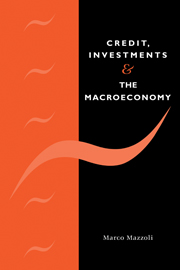Book contents
- Frontmatter
- Contents
- Preface and acknowledgements
- 1 Introduction
- Part I Banks, credit and the macroeconomy: a puzzle
- Part II Interactions between credit and industry: firms' market power and banks' liquidity preference
- 4 Investments and monetary policy with oligopsony in the market for credit
- 5 Banks' assets and liquidity preference: an empirical investigation based on the free liquidity ratio for commercial banks
- Part III ‘Inside-the-firm’ interactions between finance and investments
- Summing up …
- Bibliography
- Index
5 - Banks' assets and liquidity preference: an empirical investigation based on the free liquidity ratio for commercial banks
from Part II - Interactions between credit and industry: firms' market power and banks' liquidity preference
Published online by Cambridge University Press: 03 February 2010
- Frontmatter
- Contents
- Preface and acknowledgements
- 1 Introduction
- Part I Banks, credit and the macroeconomy: a puzzle
- Part II Interactions between credit and industry: firms' market power and banks' liquidity preference
- 4 Investments and monetary policy with oligopsony in the market for credit
- 5 Banks' assets and liquidity preference: an empirical investigation based on the free liquidity ratio for commercial banks
- Part III ‘Inside-the-firm’ interactions between finance and investments
- Summing up …
- Bibliography
- Index
Summary
Introduction
Chapter 4 contains a model of oligopsony in the credit market and analyses the implications of an exogenous change in the market structure for the investments and the transmission mechanism of monetary policy. The analysis has been conducted within standard portfolio model à la Tobin and Brainard and not within a ‘creditist’ model in order to stress the fact that the issue of oligopsony in the credit market is not only relevant for the credit view, but also for more conventional modelling approaches. We begin this chapter by reversing the issue and pointing out a possible paradox: even in a completely bank-oriented financial system, without security markets, if the free liquid reserves are the mere result of unexpected shocks and the banks do not hold them as a deliberate investment (or even ‘noninvestment’) decision, then the conventional ‘money view’ (and not the ‘credit view’) would hold. In other words, the correlation between bank credit and output would be a spurious regression determined by the banks' balance sheet constraint. This means that in a non-securitized financial system it might not be necessarily true that banks' assets are as relevant as money stock for the transmission mechanism of monetary policy, unless the investment decisions of the banking system, as well as its liquidity preference, can be modelled within an investment decision framework, where subjective valuations of profitability and risk play a precise role.
- Type
- Chapter
- Information
- Credit, Investments and the MacroeconomyA Few Open Issues, pp. 110 - 132Publisher: Cambridge University PressPrint publication year: 1998



